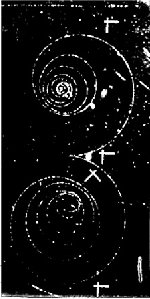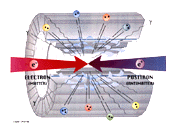
photo:
CERN
This
bubble chamber photograph shows an electron and a positron
(anti-electron) spiralling in opposite directions.
|

Antimatter found its way into the popular imagination soon
after its discovery in the early 1930s. "Star Trek"
fans know antimatter as the high-energy fuel of the Enterprise,
the stuff that sends the starship faster than the speed
of light. That kind of space travel isn't likely to materialize.
But the theoretical possibilities of antimatter have long
seduced science fiction aficionados and scientists with
promises of amazing revelations about the nature of distant
galaxies and the origins of the universe.
Perhaps
the most amazing thing about antimatter is that it was conceived
of at all. In 1928, British physicist Paul Dirac set out
to solve a problem: how to reconcile the laws of quantum
theory with Einstein's special theory of relativity. Through
complex mathematical calculations, Dirac managed to integrate
these disparate theories. He explained how things both very
small and very fast -- in this case, electrons near the
speed of light -- behave. This was a remarkable achievement
in its own right, but Dirac didn't stop there. He realized
that his calculations would work for an electron with negative
charge, but also for an electron with positive charge --
an unanticipated result.
Dirac
argued that this anomaly was in fact the electron's "antiparticle,"
the subatomic equivalent of the "evil twin." In
fact, he asserted, every particle has an "antiparticle"
with nearly identical properties, except for an opposite
electric charge. And just as protons, neutrons, and electrons
combine to form atoms and matter, antiprotons, antineutrons,
and antielectrons (called positrons) combine to form antiatoms
and antimatter. His findings led him to speculate that there
may even be a mirror universe made entirely of antimatter.

art:
CERN
Many
new particles are produced by the annihilation of an
electron and a positron
|
Dirac's
equations marked the first time something never before seen
in nature was
"predicted"
-- that is, assumed to exist based on theoretical rather than
empirical evidence -- solely on the basis of theory guided
by the human imagination. His prediction would be confirmed
in experiments by Carl Anderson in 1932. Both men won Nobel
prizes for their efforts.
Physicists have learned a great deal about antimatter since
Anderson's discovery. One of the more dramatic findings (custom-made
for many a science fiction adventure) is that antimatter and
matter explode on contact. Like lovers caught in a doomed
relationship, matter and antimatter initially attract (thanks
to their opposite charges) and then destroy each other. Because
these annihilations produce radiation, scientists can use
instruments to measure the "wreckage" of their fatal
collisions. No experiments have yet been able to detect the
antigalaxies or vast stretches of antimatter in space that
Dirac imagined. Scientists still send observatories into space
to look for them, though, just in case.

photo:
CERN
CERN's
Antiproton Decelerator
(AD) slows down high-energy antiprotons so that their
properties can be studied.
|
But the question that really confounds physicists today springs
from the same fountain that captured the imagination of the
public: that matter and antimatter annihilate when they meet.
All the theories of physics say that when the universe burst
into existence some fifteen billion years ago with the
Big
Bang
, matter and antimatter existed in equal amounts.
Erupting from a celestial cauldron of unfathomable temperatures,
matter and antimatter materialized and then annihilated repeatedly,
finally disappearing back into energy, known as the cosmic
background radiation. The laws of nature require that matter
and antimatter be created in pairs. But within a millifraction
of a second of the Big Bang, matter somehow outnumbered its
particulate opposite by a hair, so that for every billion
antiparticles, there were a billion and one particles. Within
a second of the creation of the universe, all the antimatter
was destroyed, leaving behind only matter. So far, physicists
have not been able to identify the exact mechanism that would
produce this apparent "asymmetry," or difference,
between matter and antimatter to explain why all the matter
wasn't also destroyed.

Is there an anti-universe? What would it look like?
Rolf Landua
describes the goal of the
ATHENA
experiment.
You
will need
RealPlayer
in order to view this video.
|
Today, antimatter appears to exist primarily in cosmic rays
-- extraterrestrial high-energy particles that form new particles
as they penetrate the earth's atmosphere. And it appears in
accelerators like CERN's, where scientists create high-energy
collisions to produce particles and their antiparticles. Physicists
study the properties and behavior of manufactured antiparticles,
and the antimatter they form when they combine, hoping to
find clues to this asymmetry mechanism.
Most scientists believe that a subtle difference
in the way matter and antimatter interact with the forces
of nature may account for a universe that prefers matter,
but they haven't been able to definitely confirm that difference
in experiments. Theories suggest that even if equal amounts
of matter and antimatter were created with the Big Bang, disparities
in their physical properties -- such as decay rate or life
span -- might favor a matter-filled world. In 1967, Russian
theoretical physicist Andrei Sakharov postulated several (rather
complex) conditions necessary for the prevalence of matter.
One required something called "charge-parity" violation,
which is an example of a kind of asymmetry between particles
and their antiparticles that describes the way they decay.
By comparing the way particles and antiparticles move, interact,
and decay, physicists have been trying to find evidence of
that asymmetry ever since.

Is the proton a mirror image of the antiproton?
John Eades
describes the goals of the
ASACUSA
experiment at CERN. You will need
RealPlayer
in order to view this video.
|
To
find that evidence, physicists conduct two types of extremely
difficult experiments, in an effort to observe matter and
antimatter directly. One produces antiparticles and antimatter
from high-energy collisions in particle accelerators, and
then makes precision measurements of them; these measurements
are then compared with everything we know about their matter
opposites to identify any detectable differences.
Whatever the outcome of such experiments, physicists will
continue to push the limits of human imagination trying to
fix this little hole (albeit not the only one) in their beautiful
theory. While theoretical physics manages to explain with
extreme precision a good part of what we know about the laws
of nature -- as experiments confirm -- so far, asymmetry doesn't
quite fit into the framework. But who knows? In their search
for that elusive mechanism that would help explain the mystery
of why we're here, physicists might uncover something totally
unexpected, opening the door to an amazing new discovery no
one has yet imagined.
EXTERNAL
LINKS
For more information on antimatter:
Antimatter:
Mirror of the Universe
For
information on the antimatter experiments at CERN:
Antimatter
Factory
ATHENA
ATRAP
ASACUSA
|